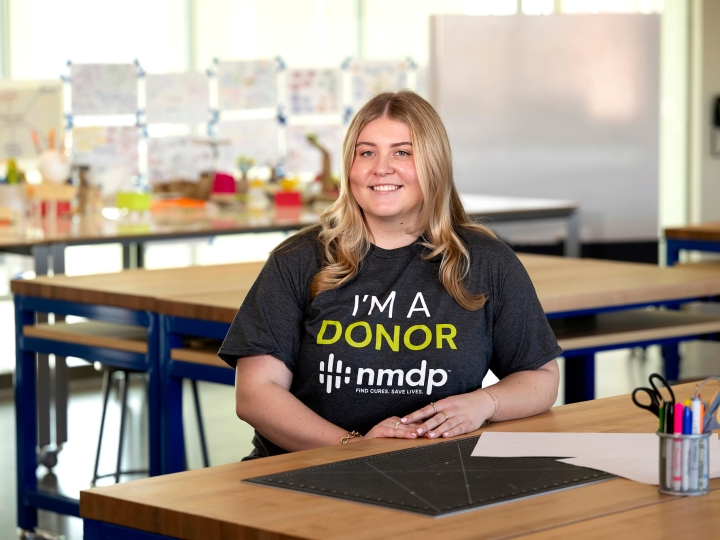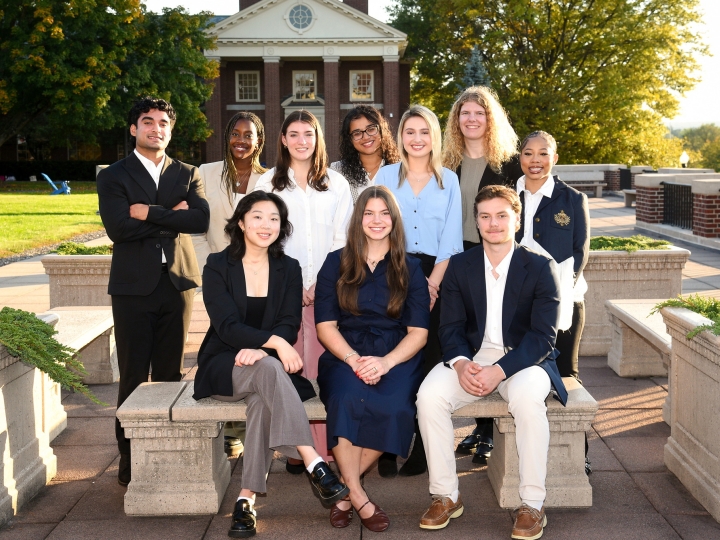
Sculpting a Legacy
July 12, 2017
Bucknell’s first Black graduate is prominently recognized on campus
Lewisburg resident and Bucknell Black Alumni Association (BAA) President Kendy Alvarez '06 embarks on her morning walk with anticipation these days. She walks through the Malesardi Quad in front of Vaughan Literature, as always, but when she reaches the southeast corner of the building and looks left, she encounters a new Bucknell landmark. Looking out with dignity is a bust of Bucknell's first African-American graduate, Edward McKnight Brawley, Class of 1875, M1887. To see Brawley's bronze likeness "means a lot," she says.
During Reunion, June 1–4, BAA members and guests celebrated the installation of the Brawley sculpture, which is the centerpiece of a new corner of campus that pays tribute to him as well as to a 1958 visit to Bucknell by the Rev. Martin Luther King Jr. Words from King and Brawley are inscribed on the sculpture's pedestal, which is the central element of a new seating area that includes a listening post where visitors can learn about these milestones in Bucknell's history.
Brawley attended Bucknell before the end of Reconstruction, a time when few African-Americans had the opportunity to attend college. Following graduation, Brawley became a minister and religious studies scholar as well as a journalist. He was president of Selma University and Morris College, which he helped found. His son, Benjamin Brawley, was a noted scholar, author, college professor and the first dean of Morehouse College.
Ed Robinson '86, founding chair of the BAA, thinks Brawley's connection to Bucknell's Baptist history is important as well. "Our Baptist founders had the ability to look beyond color and really embrace African-American students, especially early on. To be in a space that recognizes our long history as part of the fabric of the institution is inspiring for current students and alumni."
In 1993, the BAA established the Brawley Fund, which provides grants to students of color to participate in workshops, research opportunities, internships and off-campus study. One funded project, a Black history timeline at Bucknell, was created by Marissa Calhoun '10. Her project, Alvarez says, inspired the celebration of the 140th Anniversary of Black History at Bucknell during Homecoming 2015, an event attended by Brawley's descendants.
These tributes to African-American contributions at Bucknell inspired Professor Carmen Gillespie, English, to propose that Professor Joe Meiser, art & art history, be commissioned to sculpt a visible and permanent tribute to honor Brawley's legacy. Support came from from the Office of the President, the BAA, Provost Barbara Altmann, the Griot Institute for Africana Studies, the President's Diversity Council, Development & Alumni Relations, Communications, Facilities and the Samek Art Museum.
Bucknell, says Gillespie, "was the first extant private school in Pennsylvania to admit an African-American student. It is also equally essential to recognize the inequalities of the past and how much work we must continue to do to ensure that Bucknell becomes the institution Brawley and King both advocated for in their lives and work."
The sculpture was unveiled in May at a public event for the campus community, preceding the Reunion celebration. The BAA will hold a larger tribute during Homecoming this fall.
"Edward McKnight Brawley began an enduring history of academic excellence among Black students at Bucknell," remarks Alvarez. "The bust being erected in such a prominent place gives students of color a sense of inclusion that is sometimes missing because they don't always see themselves represented on campus. If you don't know your history, you don't really understand whose shoes you're walking in. It serves as a reminder to all Bucknellians to carry on the legacy of diversity and inclusion so central to the success of our campus community."
For more about Bucknell's first African-American graduate, go to bucknell.edu/Brawley.

